|
|
|
WWII
Invasion Defences Paulsgrove
Spigot Mortar |
|
| Created 22-06-2003 Last update
25-01-2007 |
|
|
|
|
|
|
|
|
Many people
have e-mailed me about a "gun emplacement" to the east of Paulsgrove
Chalkpit which they used to play in when they were children, and all
references to its location tied up very nicely. Through the UK
Fortifications Club I learnt that the
emplacement was in fact a Spigot Mortar Weapons Pit and was last
recorded in the mid 1980s. This was an important
find, and had to be investigated further. During these
investigations it became apparent that the whole area formed part of a
World War Two anti-invasion defence site.
|
|
|
|
|
|
|
|
|
After
numerous visits to the area, it appeared that the Weapons Pit did not exist any
more (2003). However there are some clumps of very thick undergrowth
around and with the help of a friend - Andy Martin - who just happens
to be a tree surgeon we searched again. It could not be found and it
must now be assumed that the site has been destroyed.
|
|
|
|
|
|
|
|
|
The Spigot
Mortar or "Blacker Bombard" was invented by Lieutenant-Colonel
Blacker with the aim of providing cheap and easily produced weapons
after most of the British Army's heavy equipment had been lost at
Dunkirk. Other field weapons invented for the same purpose during this
period were the Northover Projector and the Smith Gun. It fired a 20lb
fin-stabilised high explosive mortar bomb propelled by black powder, and
had an effective range of 100yds in its anti-tank role and up to 450yds when firing a lighter anti-personnel bomb.
It had one major drawback in that when the warhead hit its target, the fins would often fly backwards
endangering the firing crew.
In its static defence role, the mortar was mounted on a steel pin set into a substantial base of
reinforced concrete. This was in turn set within a camouflaged weapons pit to offer some protection to the three man gun crew. A
portable mount was also available, but weighed around 350lb and took 3
men to move it.
The spigot mortar was rejected by the regular army but saw service with Home Guard and airfield protection units from 1941-1944.
|
|
|
|
|
Aerial
photo site location |
|
Grid Ref SU639065
|
|
Visit
this site - Portsdown Walk No2
|
|
|
With
thanks to:
UK
Fortifications Club, Andy Martin, Derek Britton, Mark Wallace,
David Tabner
|
|
|
|
|
|
|
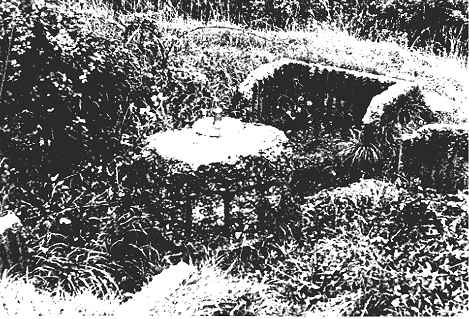
|
|
The
only (photocopied) photo of the Paulsgrove Spigot Mortar Weapons
Pit known to exist, taken in the mid 1980s. The cylindrical lump
of concrete has a 29mm stainless steel pin set in it on which the
weapon was mounted. The pin would have had a crown and crowsfoot
stamped on it as it was regarded as part of the ordnance. The pit
itself has been lined with concrete - the corrugated iron
shuttering marks can still be seen. The shape of the pit allows
room for the crew to maneuver and provides space for ammunition
lockers. |
|
|
|
|
|
|
|
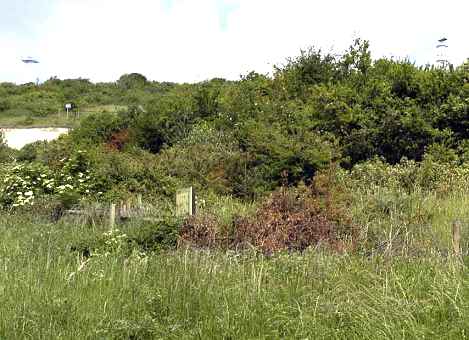
|
|
This
is the area east of Paulsgrove Chalkpit where the Spigot
Mortar was located. The edge of the Chalkpit can be seen
on the upper left.
Copyright
Derek Britton |
|
|
|
|
|
|
NEW
- 25-01-2007 |
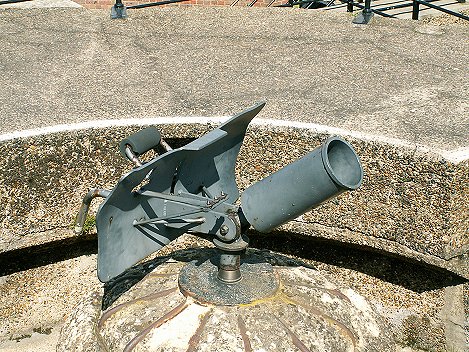
|
|
An original Spigot Mortar at Tilbury Fort in Essex
situated in a 6 inch gun emplacement. The curved steel
armour plate behind the barrel was to protect the gun crew
from the consequences of firing it.
Photo by: David Tabner |
|
|
|
|
|
|
NEW
- 25-01-2007 |
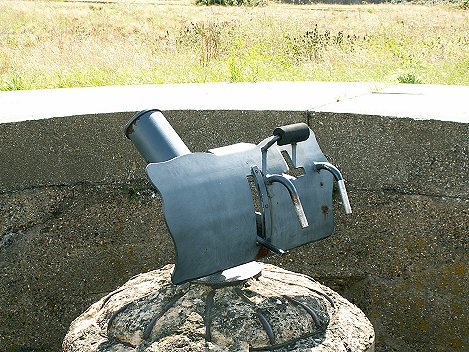 |
|
A rear view of the mortar shows the primitive aiming
controls. The two downward facing handles were used
for direction whilst the straight bar protruding through
the slot controlled elevation. A gunner would rest his
forehead on the rest and take aim through the inverted 'T'
slot. For an account of what happened next read the email
from Harry Bradbury below.
Photo by: David Tabner |
|
|
|
|
|
|
|

|
|
There
is evidence of further anti-invasion defences in the area.
Here is an anti-tank ditch above the Chalkpit. Portsmouth
Harbour is in the back ground. |
|
|
|
|
|
|
|
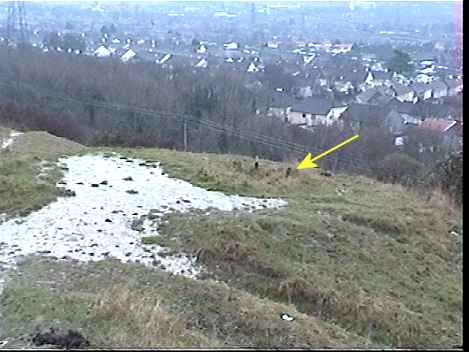
|
|
The
arrow indicates a filled in weapons pit which would have
had a good command of the high ground. The metal posts
holding the expanded steel retaining walls can be made
out. Research into this area is ongoing. |
|
|
|
|
NEW
- 20-01-2007 |
|
|
Going
through the web site of Portsdown Tunnels under 'Invasion' I
came across the Spigot Mortar; the Blacker Bombard. During part of
my time spent as a Private in the Chesterfield Home Guard I was in the Blacker Bombard
Squad. However during my 5 years in the Army (infantry) nobody I
spoke to had ever heard of the Blacker Bombard. Old soldiers I
have spoken to since had never heard of it and I feel sure they
thought that I was making it up. Thank you very much for providing
the proof that there was such a weapon.
The base
of the Mortar had four legs made out of 2 inch red band tube which
slotted into the base of the Mortar itself. We were suppose to be
mobile. When firing it we had to lay down and there was a padded
roller at the end of the firing butt and you had to rest your head
on this to look through the site. When you fired the thing the
front end jumped up and the roller hit your forehead and nearly
broke your neck. I only fired this contraption once thank
goodness. The Blacker Bombard squad consisted of six men and a
Sergeant. It was really the days of Dads' Army. At 18 I joined the
real Army.
Harry Bradbury, Derbyshire - January 2007
|
|
|
|
|
|
|
|
|
|
|
|
|

|





